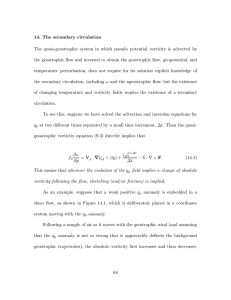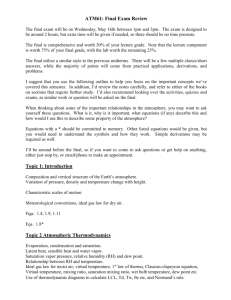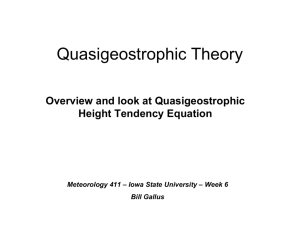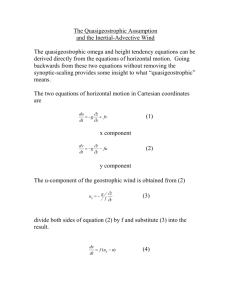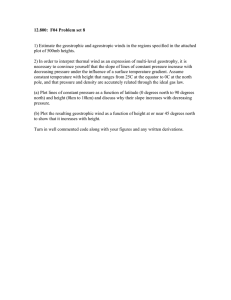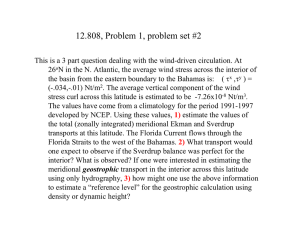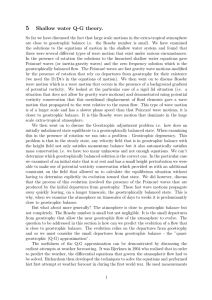1 QG Theory and Applications: Approximations and Equations
advertisement
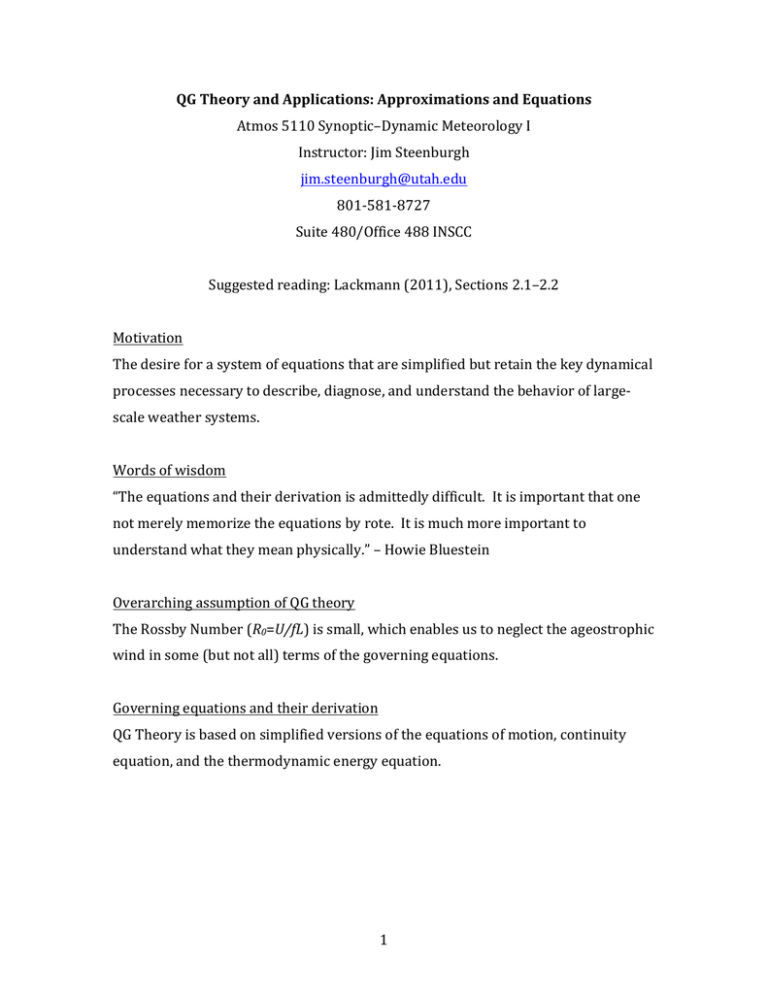
QG Theory and Applications: Approximations and Equations Atmos 5110 Synoptic–Dynamic Meteorology I Instructor: Jim Steenburgh jim.steenburgh@utah.edu 801-­‐581-­‐8727 Suite 480/Office 488 INSCC Suggested reading: Lackmann (2011), Sections 2.1–2.2 Motivation The desire for a system of equations that are simplified but retain the key dynamical processes necessary to describe, diagnose, and understand the behavior of large-­‐ scale weather systems. Words of wisdom “The equations and their derivation is admittedly difficult. It is important that one not merely memorize the equations by rote. It is much more important to understand what they mean physically.” – Howie Bluestein Overarching assumption of QG theory The Rossby Number (R0=U/fL) is small, which enables us to neglect the ageostrophic wind in some (but not all) terms of the governing equations. Governing equations and their derivation QG Theory is based on simplified versions of the equations of motion, continuity equation, and the thermodynamic energy equation. 1 Horizontal momentum equation Derivation 1. Break down the momentum into geostrophic and ageostrophic components 𝑉 = 𝑉! + 𝑉!" 2. Neglect the following (by scale analysis) • Friction • Advection by the ageostrophic wind and vertical velocity • Advection of ageostrophic momentum • Local ageostrophic momentum tendency 𝜕𝑉! 𝜕𝑉!" 𝐷𝑉 𝜕𝑉 = + 𝑉 ∙ ∇𝑉 = + + 𝑉! ∙ ∇𝑉! + 𝑉! ∙ ∇𝑉!" + 𝑉!" ∙ ∇𝑉! + 𝑉!" ∙ ∇𝑉!" 𝐷𝑡 𝜕𝑡 𝜕𝑡 𝜕𝑡 𝜕𝑉!" , 𝑉 ∙ ∇𝑉!" , 𝑉!" ∙ ∇𝑉! , 𝑉!" ∙ ∇𝑉!" = 0 𝜕𝑡 ! and in 𝑉! ∙ ∇𝑉! 𝜔 ⇒ 𝜕𝑢! 𝜕𝑣! ,𝜔 = 0 𝜕𝑝 𝜕𝑝 𝐷𝑉! 𝐷𝑉 𝜕𝑉! ≅ + 𝑉! ∙ ∇! 𝑉! = 𝐷𝑡 𝜕𝑡 𝐷𝑡! where 𝐷 𝜕 𝜕 𝜕 = + 𝑢! + 𝑣! 𝐷𝑡! 𝜕𝑡 𝜕𝑥 𝜕𝑦 2 Physical interpretation: The rate of change of momentum following parcel motion is approximately equal to the rate of change of geostrophic momentum following geostrophic motion 3. Assume a midlatitude β-­‐plane (Taylor expansion approximation for f) 𝑓 = 𝑓! + 𝜕𝑓 𝜕!𝑓 𝑦! 𝑦 + ! + ⋯ 𝜕𝑦 𝜕𝑦 2 Ignoring higher order terms 𝑓 = 𝑓! + 𝜕𝑓 𝑦 = 𝑓! + 𝛽𝑦 𝜕𝑦 This allows 𝑓! to replace f in the geostrophic wind relationship, which becomes 𝑉! = 1 k×∇Φ 𝑓! Or alternatively, 𝑓! 𝑘×𝑉! = −∇Φ 4. Use the above assumptions and relationships to rewrite the horizontal momentum equation 𝐷𝑉 = −∇Φ − 𝑓𝑘×𝑉 𝐷𝑡 as 𝐷𝑉! = 𝑓! 𝑘×𝑉! − (𝑓! + 𝛽𝑦)𝑘×(𝑉! + 𝑉!" ) 𝐷𝑡! = 𝑓! 𝑘×𝑉! − 𝑓! 𝑘×𝑉! − 𝑓! 𝑘×𝑉!" − 𝛽𝑦𝑘×𝑉! − 𝛽𝑦𝑘×𝑉!" = −𝑓! 𝑘×𝑉!" − 𝛽𝑦𝑘×𝑉! − 𝛽𝑦𝑘×𝑉!" 3 5. Using scale analysis it can be shown that 𝛽𝑦𝑘×𝑉!" can be neglected, yielding the final form of the QG momentum equation 𝐷𝑉! = −𝑓! 𝑘×𝑉!" − 𝛽𝑦𝑘×𝑉! 𝐷𝑡! Physical interpretation: The first right hand term represents the Coriolis force acting on the ageostrophic wind, which in turn leads to an acceleration of the geostrophic flow perpendicular to the ageostrophic wind. I’ve yet to come up with a good interpretation of the second term on the right hand side! Hydrostatic Approximation (pressure coordinate form) 𝜕Φ 𝑅𝑇 = − 𝜕𝑝 𝑝 Continuity Equation 𝜕𝑢 𝜕𝑣 𝜕𝜔 + + = 0 𝜕𝑥 𝜕𝑦 𝜕𝑝 Which can be written 𝜕𝑢!" 𝜕𝑣!" 𝜕𝜔 + + = 0 𝜕𝑥 𝜕𝑦 𝜕𝑝 Since 𝜕𝑢! 𝜕𝑣! + = 0 𝜕𝑥 𝜕𝑦 Proof: 𝑉! = 𝑢! = − 1 k×∇Φ 𝑓! 1 𝜕Φ , 𝑓! 𝜕𝑦 𝑣! = 1 𝜕Φ 𝑓! 𝜕𝑥 𝜕𝑢! 𝜕𝑣! 𝜕 1 𝜕Φ 𝜕 1 𝜕Φ + = − + = 0 𝜕𝑥 𝜕𝑦 𝜕𝑥 𝑓! 𝜕𝑦 𝜕𝑦 𝑓! 𝜕𝑥 4 Physical interpretation: The geostrophic wind is nondivergent. Divergence and vertical velocity are associated with the ageostrophic flow. Thermodynamic Energy Equation Similar to momentum, neglects the advection of temperature by the ageostrophic wind, however, the effects of vertical velocity are retained since vertical velocity has a major influence on temperature through adiabatic warming and cooling. 𝐷𝑇 𝜎𝑝 𝐽 − 𝜔 = 𝐷𝑡! 𝑅 𝐶! where 𝜎=− 𝑅𝑇 𝑑𝑙𝑛𝜃 𝑅𝑇 1 𝑑𝜃 = 𝑝 𝑑𝑝 𝑝 𝜃 𝑑𝑝 Thus, σ is proportional to static stability. Typically we assume the flow is adiabatic (i.e., J=0), but it is possible to include diabatic effects if desired (we won’t for now). Summary The QG momentum equation, geostrophic wind relationship, hydrostatic approximation, continuity equation, and thermodynamic energy equation form a closed set of equations for the dependent variables Φ, 𝑉! , 𝑉!" , 𝜔, and T. 𝐷𝑉! = −𝑓! 𝑘×𝑉!" − 𝛽𝑦𝑘×𝑉! 𝐷𝑡! 𝑉! = 1 k×∇Φ 𝑓! 𝜕Φ 𝑅𝑇 = − 𝜕𝑝 𝑝 𝜕𝑢!" 𝜕𝑣!" 𝜕𝜔 + + = 0 𝜕𝑥 𝜕𝑦 𝜕𝑝 𝐷𝑇 𝜎𝑝 𝐽 − 𝜔 = 𝐷𝑡! 𝑅 𝐶! 5 Geostrophic Relative Vorticity Derived by taking the curl of the geostrophic wind 𝜁! = ∇×𝑉! = ∇× 1 1 𝑔! k×∇Φ = ∇! Φ = ∇! Z 𝑓! 𝑓! 𝑓! Key points: ! • Whenever you see ! ∇! Φ, think 𝜁! • Cyclonic (positive in NH) 𝜁! associated with minima in Z • Anticyclonic (negative in NH) 𝜁! associated with maxima in Z ! QG Vorticity Equation Derived by taking the curl of the QG momentum equation (i.e., 𝜕/𝜕𝑥 of the 𝜕𝑢! /𝜕𝑡! equation and 𝜕/𝜕𝑦 of the 𝜕𝑣! /𝜕𝑡! equation) 𝜕𝜁! 𝜕𝜔 = −𝑉! ∙ ∇ 𝜁! + 𝑓 + 𝑓! 𝜕𝑡 𝜕𝑝 What changes the geostrophic relative vorticity at a point? • Geostrophic absolute vorticity advection o o • !!! !" !!! !" > 0 if advection is cyclonic (i.e., positive in NH) < 0 if advection is anticyclonic (i.e., negative in NH) Stretching & compression (or convergence and divergence) o o !!! !" !!! !" > 0 if stretching (NH) < 0 if compression (NH) Alternatively, we can write the QG vorticity equation as: 𝐷𝜁! 𝜕𝜔 = 𝑓! 𝐷𝑡 𝜕𝑝 6 Which basically says that following the flow, only stretching (i.e., convergence) and compression (i.e., divergence) cause the geostrophic absolute vorticity to increase or decrease, respectively. 7
